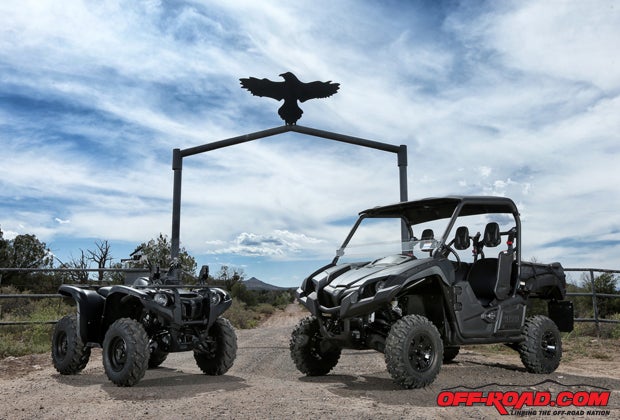
If you’re an avid shooter like I am, nothing could be better than getting an invitation to attend one of the country’s premier firearms training facilities for some hardcore instruction while also being able to sample an awesome UTV and ATV at the same time.
And that’s just what happened when Yamaha invited me to attend a press event at the Gunsite Academy near Prescott, Arizona. On top of the top-tier firearms instruction using brand new rifles and pistols supplied by event co-sponsor Ruger, Yamaha brought along a bunch of its all-new 2014 Viking 700 SE Tactical Black UTV and Grizzly 700 SE Tactical Black ATV models.
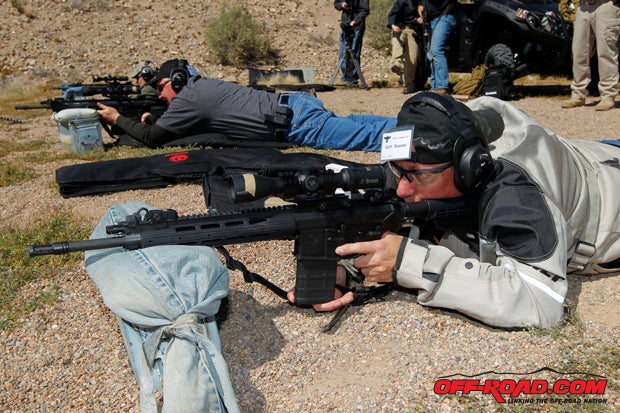
I have to admit, though, that prior to attending this amazing event I had no idea just how powerful and focused Yamaha’s “Yamaha Outdoor” marketing brand really was. It targets folks who maybe didn’t know or care much about ATVs and UTVs and shows them just how well those vehicles fit into the outdoor lifestyles of hunting, fishing and the like. To get its message heard, Yamaha has forged alliances with outdoor and hunting groups such as Buckmasters and Ducks Unlimited, firearm organizations such as the National Rifle Association and Gunsite, and veteran’s groups such as Honored American Veterans Afield. These partnerships truly position Yamaha much differently than its Japanese competitors, according to Yamaha ATV/SxS Marketing Manager Steve Nessl, who says that Yamaha’s growing relationship with Gunsite is just one more positive example.
“It is really outside the box for an ATV or Side-by-Side manufacturer to come out here and be involved in the shooting sport, hang out with these tactical gun writers and law enforcement shooting specialists, and to be an authentic, incredible part of it by taking Vikings and Grizzlies out to coordinates and shoot targets,” Nessl said. “I don’t think anyone [from the firearms community] is questioning why we are here, and that is good for us. It is good for us to be accepted as part of this community.”
But Yamaha’s intended audience is also a very discerning group, and it knows the difference between products that deliver high performance, durability and reliability, and those that don’t. And if there’s one thing that the outdoorsman crowd shares in common with the motorcycle/ATV/UTV crowd, it’s a genuine distaste for wannabe products that don’t perform as they should. With its all-new Viking 700 SE Tactical Black UTV and significantly revised Grizzly 700 SE Tactical Black ATV, Yamaha has seriously hit its targets in marksman-like fashion.
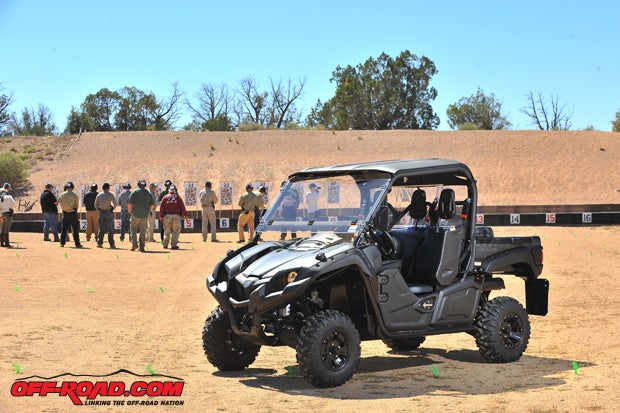
Viking 700 SE Tactical Black
Yamaha’s new Viking 700 platform was a winner right out of the box with us, and the Viking 700 SE Tactical Black with Electric Power Steering (EPS) is just more off a good thing. You can read our off-road impression of the non-EPs Viking 700 here.
But let’s revisit the basic platform. Designed to replace Yamaha’s popular-selling Rhino in the Yamaha family of UTVs, the Viking 700 is a Utility Sport-class vehicle designed for work and play. (Sorry, Sport UTV fans—but we hear that a sport UTV is coming soon!) Its 686cc, fuel-injected, SOHC, four-valve single-cylinder engine offers plenty of torque, and the engine’s power pulses are delivered seamlessly to the drive wheels via Yamaha's Ultramatic dual range (high/low) transmission. The key to this smooth performance, says Yamaha, is in its full oil-batch centrifugal clutch arrangement, which maintains constant belt tension regardless of rpm or load and significantly increases belt life. This differs from sheave-style snowmobile CVTs in which the belt is constantly stretching and moving as rpm and load vary.
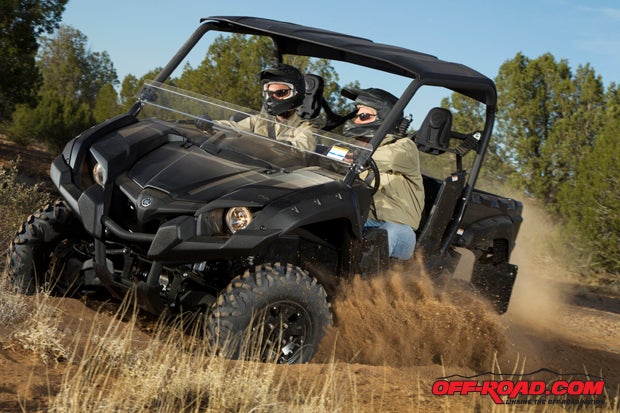
The Viking’s 84.1-inch wheelbase steel chassis is built to last. It boasts 11.8 inches of ground clearance and 8.1 inches of suspension travel, and the chassis itself is designed for rugged use, with flat, welded steel skid plates for underbody protection and upswept frame edges to reduce the chance of snagging the Viking on rocks, stumps and the like. Yamaha claims a total weight of 1,342 pounds for the Viking, which can accommodate an additional 600 pounds of cargo capacity in its sturdy steel bed.
Yamaha calls the Viking the only “true three-passenger UTV on the market.” We know, there are several four-passenger vehicles are in the marketplace already, but Yamaha deserves a lot credit for not only building a UTV with a unique, three-passenger cockpit layout, but for building it the right way. The Viking can carry three hefty male adults comfortably without the uncomfortable inconvenience of having them bump shoulders during the ride. Yamaha accomplished this comfort goal by setting the middle seat’s bucket five degrees behind the outer seats to offset the middle passenger’s shoulders.
The Viking also features a spacious, textured footwell area, with plenty of dedicated foot space for each passenger. The footwell area also contains a safety-improving barrier between the driver and the middle passenger that makes it difficult for the middle passenger to inadvertently reach the foot controls in rough terrain. And both passengers can easily reach the Viking’s two-step passenger hand hold for extra stability when the going gets rough.
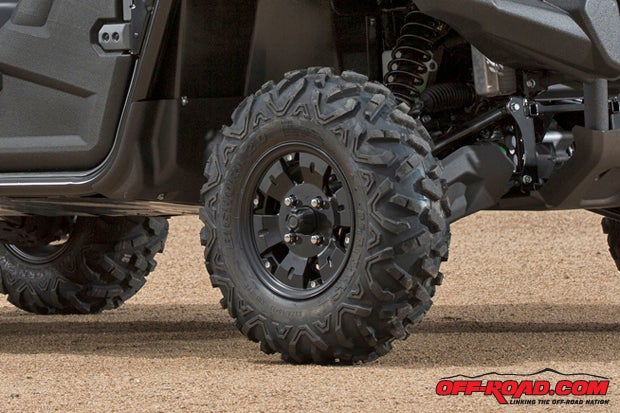
But the Viking’s EPS provides light and predictable steering performance with excellent feedback in any terrain, and it may be the machine’s single best feature. The system’s consistent feel is no accident. It was carefully engineered by the inclusion of a potentiometer that monitors torque on the system through the steering system in both directions—whether from the driver or from the trail—and compensates by adjusting the amount of power steering assist. Torque on the system signals the EPS to deliver more or less assist. The EPS comes standard on the Tactical Black model and is a $1000 option on other Viking models. Having tested both versions, we can’t imagine anyone not wanting to opt for EPS.
Checking in at $13,749, the Viking 700 SE Tactical Black represents the top of the line for the Viking platform and includes the Special Edition matte Tactical Black paint scheme along with a few handy Genuine Yamaha accessories, such as Yamaha’s accessory rail mounting system in the bed. The system allows easy lock-down and swapping of a host of other Yamaha accessories. The SE Tactical Black also features a set of snazzy, black cast-aluminum wheels and over fenders, mud flaps, a hard sun top and an under seat storage area. For our Gunsite adventure, our Tactical Black Viking sample units were also fitted with other Genuine Yamaha accessories, such as bed mats, a folding windshield, a black rear window, left and right side mirrors and a cargo box as well as accessory heavy-duty bumpers and brush guards and accessory lighting.
Spending time riding around the Gunsite property on the Viking 700 SE Tactical Black only reaffirmed the positive vibes from my time spent testing the non-EPS Viking time. This is one sweet UTV that is ready to rock and roll no matter what you try and throw at it. As far as I am concerned, Yamaha has squarely hit the bullseye on each and every one of its performance goals for this new vehicle.
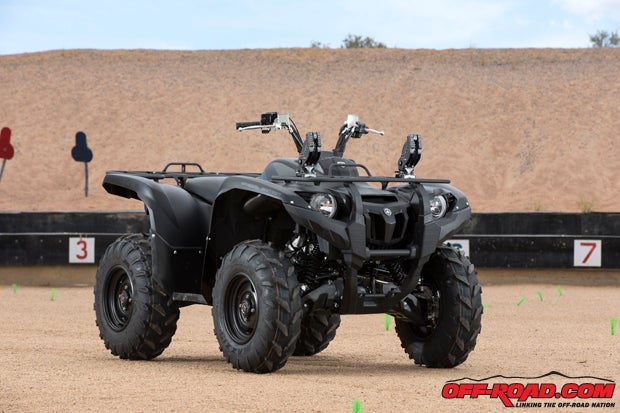
Grizzly 700 FI SE Tactical Black
The Yamaha Grizzly 700 FI already has a tremendous reputation in the Utility 4X4 ATV class. It was first introduced back in 2007, and it has been a popular seller for Yamaha ever since. Of course, it has also kept pace in the class via constant updates, and the 2014 model year is no exception.
The Grizzly 700 FI’s gets a new cylinder head and a modified piston shape intended to pull more power out of its fuel-injected, 686cc, four-stroke single in 2014. The piston change accomplishes much of this goal by bumping the engine’s compression ratio from 9.2:1 to 10.01, but Yamaha has also increased the lift of the engine’s single overhead cam while retaining the same duration. The goal, say Yamaha spokesmen, was to improve the engine’s low-end grunt without sacrificing its respectable top-end power. Durability enhancements for 2014 include a new heat treatment to the connecting rod.
The engine changes definitely give the Grizzly more get-up and go. My morning of free-riding left me impressed with its linear yet brawny motor. Throttle response through its 44mm Mikuni throttle body is crisp and clean at any rpm, load or throttle setting, thanks to a well-calibrated throttle position sensor that keeps the fueling precise. That’s an important trait for a machine that doesn’t feature a manual transmission and therefore eliminates the opportunity for the rider to downshift in the event that more rpm or power is needed, such as when dealing with an obstacle on the trail.
The Grizzly 700’s power is downright charming in its delivery, with plenty of bottom end snap and a smooth midrange pull that transitions seamlessly into a potent yet user-friendly top end. The Grizzly’s innovative Ultramatic transmission plays a big role in the electric feel of the engine while putting all of its power to the ground. The system uses a centrifugal hydraulic clutch arrangement that maintains constant belt tension for smooth power delivery and increased belt life. The sprag clutch also does an excellent job of giving the automatic transmission a proper engine-braking feel when descending hills with off throttle.
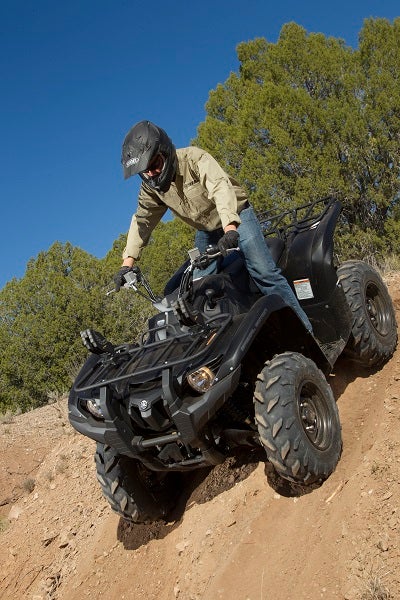
Like the Viking, the Grizzly features a three-position On-Command four-wheel-drive system that lets the rider switch between 2WD, limited-slip 4WD and a fully locked differential 4WD. Only instead of a knob, the system is accessed with the simple push of a button on the handlebar. The On-Command system also features an override button that allows engine to achieve maximum rpm when the differential is in the full-locked mode.
The 2014 Grizzly 700 FI’s steel chassis has also received a few noteworthy changes, including new 30mm longer A-arms that add 2.3 inches of width to the platform. Yamaha engineers say that the longer arms increase ride comfort without detracting from the Grizzly’s quick-handling character. The A-arms go hand-in-hand with another welcome change, a suspension travel increase. The 2014 Grizzly 700 FI’s five-way adjustable preload shocks now boast 8.6 inches up front and 9.2 inches out back, and all feature new, progressively wound springs that offer broader spring rates to help maintain the Grizzly’s linear feel through the suspension stroke. Its 10.8 inches of ground clearance is generous, but just in case the bottom rails should make contact with the ground, Yamaha has fitted the chassis with a full-length composite skid plate to take the punishment.
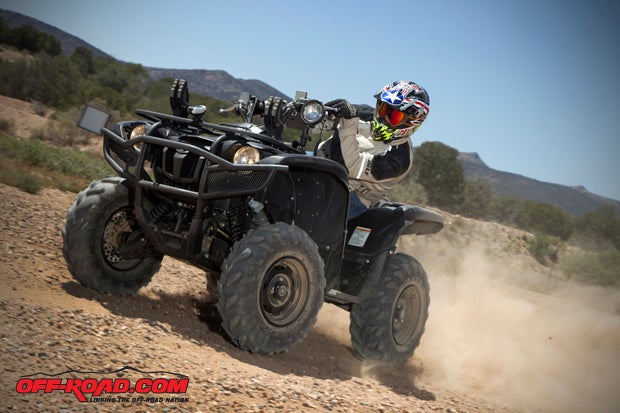
The 2014 Grizzly has also undergone changes to its steering, as Yamaha engineers have revised the Pittman arm while also adding an additional 4.2 degrees of steering lock on each side for a total of 86 degrees of total steering arc from lock to lock. These tweaks are accompanied by revised Electric Power Steering unit mapping that reduces the amount of torque required to turn the handlebar through its arc. This combination of subtle differences is intended to reduce steering effort without spoiling the overall steering feel that Grizzly customers have come to know and love.
The Grizzly is capable of tackling nasty terrain at fairly high speeds, which places a premium on steering performance and feedback. I had no issues with the EPS, which offers a noticeable yet progressive assist at slower speeds and firms up when the Grizzly is really logging on a fast road or trail. The EPS system actually makes the Grizzly feel lighter and more responsive than you’d ever imagine that a big utility ATV ever could. Yamaha also outfitted the Grizzly with new Maxxis tires (25 x 8-inch fronts and 25 x 10-inch rears) that are mounted on new cast-aluminum rims that have their bead lip reversed so that they collect less mud.
Two more things impressed me. First is the Grizzly 700’s roomy and comfortable cockpit, which offers a generously padded seat that is slim and well-contoured, along with roomy footboards that make transitioning from the seated position to the standing position feel very natural. Second are the Grizzly’s extremely linear yet powerful disc brakes, which haul its 648 lbs. (claimed wet weight, with a fully fueled 5.3-gallon tank) down from speed in a hurry if necessary.
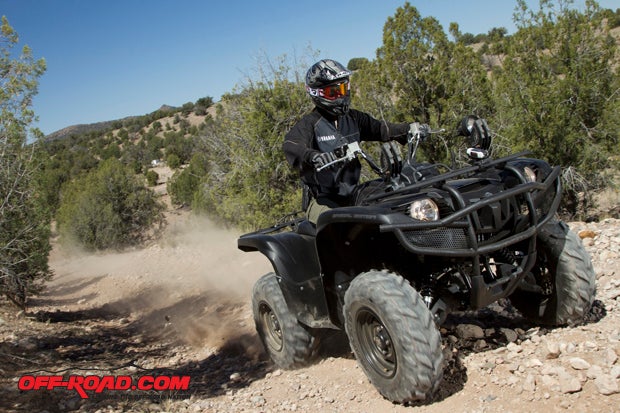
Our Grizzly test units were SE Tactical Black models, which feature the Tactical Black color scheme and graphics. Our test samples also came equipped with some useful Genuine Yamaha Accessories, including the Grizzly Heavy Duty Front Brush Guard ($261.49), Grizzly Gripper Gun Holder ($79.99) and the Grizzly Spot Light ($106.49).
At the end of the day, my thoughts on the Yamaha Grizzly 700 FI SE Tactical Black model could best be summed up by paraphrasing a popular new truck commercial that is currently running on television: Before I saw the Grizzly 700, I didn’t know what it was. Now, I want one.


 Your Privacy Choices
Your Privacy Choices